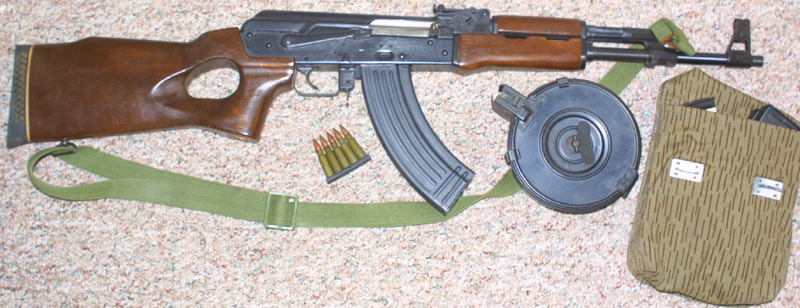 AK-47
AK-47
| Length Overall | Barrel Length | Weight | Caliber | Action Type | Magazine Capacity |
| 34.35" | 16.34" | 10.58 Pounds | 7.62x39 | Gas Semi | 30 |
In the thirties, any time the press wished to sensationalize gangsters, a Tommy gun would generally be shown or alluded to. In similar fashion, all through the sixties,
The AK is very heavy, by modern standards, weighing a bit more than an M-1 Garand, but firing a much less powerful cartridge. What it has going for it is cheapness of manufacture and a simple, foolproof design. The gun has acceptable accuracy (3"-5" groups at 100 yards), and a large capacity magazine, making it a suitable weapon for the masses of poorly trained conscripts which made up the bulk of the former comblock military.
As to the merits of the weapon itself, they are a mixed bag. The AK is compact, has a great thirty round magazine (unlike the flimsy AR-15 junk magazines), and is so reliable, that it is very nearly soldier proof. I have owned three AK's over the years. Two were Chinese, one of these being my currently owned thumbhole model, and one was Hungarian. One of the Chinese models had the side folding, bakelite stock (oh to have that gun back again). All were heavy, all were sturdily built, and very reliable. None were particularly accurate. Now I suppose it could be my shooting, but I am able to get sub one inch groups from my AR-15, Ultra Match, and just a hair over an inch with my bolt action. The AK is somewhat handicapped in the accuracy department, by its stamped receiver, and the shortness of it's sight radius. I am also talking here, about the gun in it's original 7.62x39 chambering. If the smaller caliber gun is more accurate, that is a different subject, and not one that I can respond to. I have never owned an AK-74.
The 7.62x39 cartridge is ballisticly almost a twin of the 30-30 Winchester round. The 30-30 is considered by most hunters to be a brush cartridge, usable at
This particular gun has a surprisingly rich, smooth blue finish, considering the numbers of these guns made, and the rather low price at which they are often sold. The quality of the AK can vary widely. The gun has an adjustable rear sight graduated up to a rather optimistic 800 yards. The twelve inch sight radius is little more than that of a long barreled pistol. In addition to the huge military market, which has always existed for these guns, the manufacturers are attempting to tap into the sporting arm arena with the relatively new Saiga versions of the rifle.
An interesting note on the development of this gun is that it's designer, was recently honored for his achievement. Mr. Kalishnikov was a sergeant in the Soviet army during the second world war before he developed what was to become the most pervasive military rifle in the world. It has been manufactured in a number of countries and exported to almost every trouble spot in the world. The gun's designer, now a retired colonel, lives in a small apartment and receives a pension for his wartime service equal to about $250 U.S. dollars a month. In the U.S. innovation is recognized sooner and rewarded better.
Disassembly
| After removing the magazine, pull back on the
charging handle. This will clear any rounds from the chamber, and cock the
hammer. Depressing the latch at the rear of the receiver cover will allow
it to be lifted up for removal from the receiver. |
|
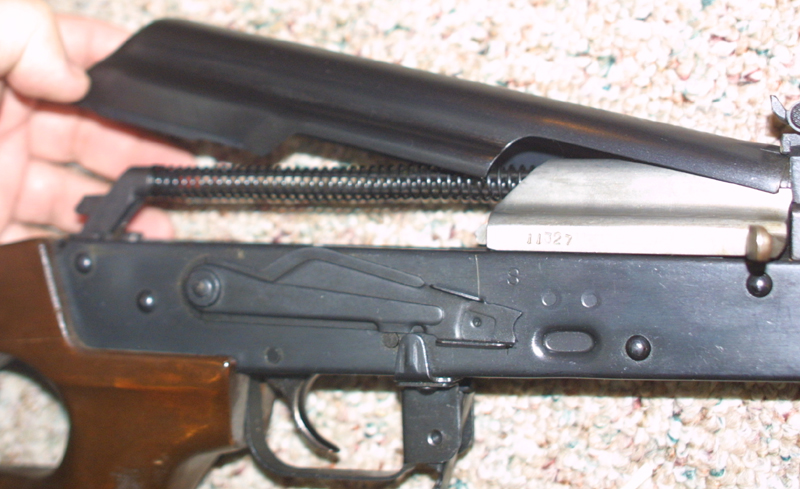
|
Removing the top cover permits access to the
workings of the gun. |
| Push forward on the latch, until it comes off
of the receiver. This will permit the recoil spring to be pulled back out
of the bolt carrier. |
|
| With the recoil spring removed, the bolt carrier
may be pulled back off of the receiver. |
|
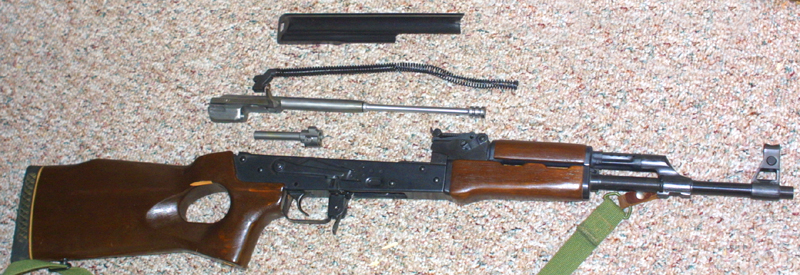
|
The AK-47 stripped for cleaning. |
| A twist of the bolt, releases it for removal
from it's carrier. |
|
| A look at the receiver, with the magazine in
place. |
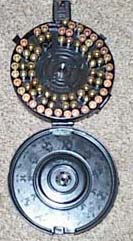 These drums are based on the drum design of the Soviet PPSH, which is in
turn a development of the old "snail shell" Luger magazine. The classic
50 round drum of the Thompson submachine gun works on similar principles,
but has
These drums are based on the drum design of the Soviet PPSH, which is in
turn a development of the old "snail shell" Luger magazine. The classic
50 round drum of the Thompson submachine gun works on similar principles,
but has 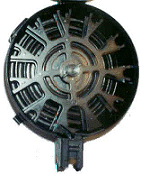 no feeder column to fit into a standard magazine well. As such, all are
key wound, and use a flat coiled spring in concert with a series of levers
and arms, called a spider, to advance the cartridges. The magazines may be
left loaded, and unwound indefinitely, without straining the magazine spring.
There are several stages involved in the loading of these magazines. The
first is to insure that all of the tension is taken off of the spring. This
is done by opening the cover on the drum, and pushing on a button in the
center of the housing. This will produce a startling click, and should make
the mechanism free turning. The next step is to turn the spider, and load
the individual sections of the magazine separately, starting with the one
to the right of the feed column. The magazine spring is then wound. A fully
loaded magazine is shown on the left, with it's cover open, and an empty
mag is shown on the right. The spider, and the spring release button in it's
center, are clearly visible in the photo of the empty drum. I presently have
two of these magazines in my collection. Since the unconstitutional magazine
ban, these have gone up in value fivefold. The loading instructions which
came with the magazine are reproduced below, for the curious, or the unfortunate
owner who has lost his manual, and forgotten how to load his drum.
no feeder column to fit into a standard magazine well. As such, all are
key wound, and use a flat coiled spring in concert with a series of levers
and arms, called a spider, to advance the cartridges. The magazines may be
left loaded, and unwound indefinitely, without straining the magazine spring.
There are several stages involved in the loading of these magazines. The
first is to insure that all of the tension is taken off of the spring. This
is done by opening the cover on the drum, and pushing on a button in the
center of the housing. This will produce a startling click, and should make
the mechanism free turning. The next step is to turn the spider, and load
the individual sections of the magazine separately, starting with the one
to the right of the feed column. The magazine spring is then wound. A fully
loaded magazine is shown on the left, with it's cover open, and an empty
mag is shown on the right. The spider, and the spring release button in it's
center, are clearly visible in the photo of the empty drum. I presently have
two of these magazines in my collection. Since the unconstitutional magazine
ban, these have gone up in value fivefold. The loading instructions which
came with the magazine are reproduced below, for the curious, or the unfortunate
owner who has lost his manual, and forgotten how to load his drum. TO LOAD MAGAZINE
1.) Unlatch and open the rear cover. Depress the spring loaded button in the center of the drum and turn the spindle
clockwise until the magazine follower is returned to the beginning of the spiral track.
2.) Insert five (5) rounds into the slots located nearest
the top (column) section of the magazine.
3.) With five rounds loaded, hold the spindle firmly in place
with one hand. With the other hand, wind the spring tensioning
key (located under the spring loaded button) CLOCKWISE three (3)
clicks.
CAUTION: Hold the spindle securely while applying tension in order
to prevent it from slipping and catching your fingers.
4.) With the spring tensioned, quickly release the spindle. The
five rounds loaded previously will be pushed to the top of the
magazine, and the last round will hold the spindle in place.
5.) At this point you have the option as to how to load the magazine.
If cartridges are dropped in the remaining slots, the
total magazine capacity will be seventy three (73) rounds. Alternately,
if the procedure described as follows is used, the
total capacity will be seventy five (75) rounds.
5A.) Tilt the column portion of the drum at a slight downward angle
and turn the spindle clockwise just slightly. Remove the
last two rounds.
5B.) Keep the drum tilted downwards, and rotate the spindle
so that the follower is returned to the beginning of the
spiral track (as in step 1).
5C.) Insert two rounds in the top section and release the
spindle. Complete loading the magazine by dropping cartridges
into the remaining slots.
WARNING: THE ABOVE PROCEDURES SHOULD ONLY BE USED WHEN LOADING THE
MAGAZINE TO
ITS FULL CAPACITY OF 73 OR 75 ROUNDS. IF THE USER INTENDS TO LOAD
ONLY A PARTIAL
MAGAZINE, THEN THE MAGAZINE FOLLOWER MUST BE DIRECTLY BEHIND THE
LAST CARTRIDGE. IF
THERE IS A GAP BETWEEN THE LAST CARTRIDGE AND THE MAGAZINE FOLLOWER,
THE DRUM MAY
BE DAMAGED DURING FIRING.
6.) With the drum fully loaded, close the rear cover and secure
with both latches. Wind the mainspring with the key located
on the rear cover. Wind the key seven (7) revolutions (360 degrees).
If the magazine is loaded to only thirty (30) rounds,
then the tension should be reduced to five (5) revolutions. DO NOT
EXCEED THE RECOMMENDED NUMBER OF
REVOLUTIONS AS THIS WILL CAUSE UNDUE WEAR OR BREAKAGE TO THE MAINSPRING.
With step six completed, the magazine is ready to use.
DURING PROLONGED PERIODS OF STORAGE:
Open the rear cover and depress the spring loaded button at
the center of the drum. Do not tilt the drum, as the cartridges
might fall out. Close and latch the back cover and re-tension the
spring three (3) clicks. The drum magazine can be stored
in this manner indefinitely.
TO UNLOAD THE MAGAZINE:
Open the rear cover and depress the spring loaded button at
the center of the drum. Dump the cartridges out. The rounds
in the column will need to be removed individually.
MAINTENANCE OF THE MAGAZINE:
Periodically, the magazine should be cleaned with solvent to prevent the build-up of unburned powder and grit in the spiraltrack. A significant amount of residue in the track may hinder the functioning of the drum.
To disassemble the drum magazine, open the real cover and depress the spring loaded button. Turn the spring tensioning
key COUNTER-CLOCKWISE and remove it. Next, lift the spindle out of the magazine. DO NOT DISASSEMBLE
THE MAGAZINE ANY FURTHER.